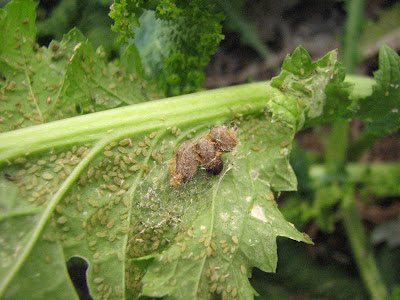With tomato seed offered by catalogues becoming so expensive it is no wonder that many gardeners are choosing to save seed for themselves. While my early attempts at saving tomato seeds left me with pretty unworkable cakes of seedy pulp stuff I now save tomato seeds very easily through the process of fermenting. All that is required is a few simple tools and a little bit of patience.
First things first – find your favorite open-pollinated (non-hybrid) or Heirloom tomato plant and pick yourself some very ripe or over-ripe tomatoes. Tomato seed is often at its best when the fruit is over-ripe though good seed can often be extracted from barely ripe fruit.
 |
| Selecting Hahms Gelbe Tomatoes for Seed Processing |
Next, you cut the tomato and squeeze out the pulp containing the seeds. When you are done squeezing out the tomatoes, you can add ½ the amount of water to seedy pulp, if desired. This may make seed processing easier for later. You can eat the outside layer of processed tomatoes, if you want. My kids sometimes stand next to where I am processing seeds and eat the outside layer when I am done squeezing out the seeds. Then put a lid on the container, label the container (if you are doing more then one type of seed) and wait.
 |
| Squeezing Tomatoes for Seed Processing |
What are you waiting for? You are waiting 1-5 days until the container produces a rotting odor and develops a bit of fuzz or a floating mat of mold. Yum! You may now be wondering why anyone would even do this. The reason why fermentation is so helpful in processing tomato seed is that fermentation breaks down the bubbles of slimy pulp covering the tomato seeds (which helps with seed storage and use) and kills pathogens that could lead to disease in the next generation of tomato plants.
 |
| A layer of mold has now formed on top of pulp mixture |
Next, remove the floating mat of mold and pour the seedy slimy mixture into some form of sieve or screen, saving the slimy pulp for now. You might need the pulpy mixture later if the mixture didn’t ferment completely. A relative gave me my screen thingy. She said she probably obtained it from a dollar store or Walgreens.
 |
| Rinsing out Tomato Seeds |
Wash out the seeds very well. If you hold a wet seed in your hand you should feel no pulp, but instead notice a very small layer of fuzz around the seed. This means you can now throw away that nasty slimy mixture. If the seeds still have a slimy coat that cannot be removed you will need to put the pulpy mixture and seeds back into the fermenting container and wait to rinse again later. If the seeds do not ferment long enough then they keep their slimy coats while if they ferment too long they will turn dark and may not sprout when planted.
 |
| Rinsed out Tomato Seeds in my Sieve thingy |
The next step should be straightforward. Put the seeds on a paper plate or something else that you can label and put in a dry undisturbed place. I have to say undisturbed because I have small children – so my undisturbed place happens to be above our cupboards. After a day of drying, I stir my seeds to see if they are dry all the way. Then write the name of the variety and the year on a bag with permanent marker, along with anything else I might want to know about the seeds and put the seeds into storage.
 |
| Hahms Gelbe seeds ready to dry |
 |
| Some finished seed - Notice the fine hairs on the seeds |
I hope that this little tutorial is helpful. In relation to seed saving, tomato plants are not very susceptible to inbreeding depression, meaning that the seed from just one healthy plant can produce a large number of high quality seeds to grow future generations of tomato plants. The ease of saving tomato seed is probably why so many tomato seed companies have sprouted up recently (no pun intended).


































